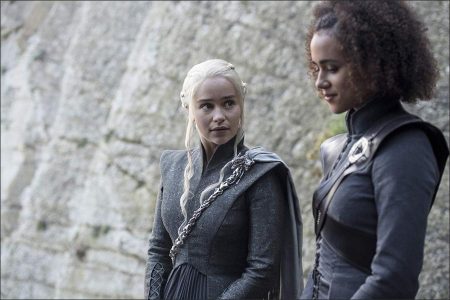Game of Thrones is an American fantasy drama television series created by David Benioff and D. B. Weiss. It is an adaptation of A Song of Ice and Fire, George R. R. Martin’s series of fantasy novels, the first of which is A Game of Thrones. It is filmed in Belfast and elsewhere in Northern Ireland, Canada, Croatia, Iceland, Malta, Morocco, Scotland, Spain, and the United States. The series premiered on HBO in the United States on April 17, 2011, and its seventh season ended on August 27, 2017. The series will conclude with its eighth season premiering on April 14, 2019.
Set on the fictional continents of Westeros and Essos, Game of Thrones has several plots and a large ensemble cast but follows three story arcs. The first arc is about the Iron Throne of the Seven Kingdoms and follows a web of alliances and conflicts among the noble dynasties either vying to claim the throne or fighting for independence from it.
The second story arc focuses on the last descendant of the realm’s deposed ruling dynasty, exiled and plotting a return to the throne. The third story arc follows the longstanding brotherhood charged with defending the realm against the ancient threats of the fierce peoples and legendary creatures that lie far north and an impending winter that threatens the realm.
Game of Thrones is roughly based on the storylines of A Song of Ice and Fire, set in the fictional Seven Kingdoms of Westeros and the continent of Essos. The series chronicles the violent dynastic struggles among the realm’s noble families for the Iron Throne, while other families fight for independence from it. It opens with additional threats in the icy North and Essos in the east.
Showrunner David Benioff jokingly suggested “The Sopranos in Middle-earth” as Game of Thrones’ tagline, referring to its intrigue-filled plot and dark tone in a fantasy setting of magic and dragons. In a 2012 study of deaths per episode, it ranked second out of 40 recent U.S. TV drama series (with an average of 14).
Themes: A Medieval Realism
The series is generally praised for what is perceived as a sort of medieval realism. George R.R. Martin set out to make the story feel more like historical fiction than contemporary fantasy, with less emphasis on magic and sorcery and more on battles, political intrigue, and the characters, believing that magic should be used moderately in the epic fantasy genre. Martin has stated that “the true horrors of human history derive not from orcs and Dark Lords, but from ourselves.”
A common theme in the fantasy genre is the battle between good and evil, which Martin says does not mirror the real world. Just like people’s capacity for good and for evil in real life, Martin explores the questions of redemption and character change. The series allows the audience to view different characters from their perspective, unlike in many other fantasies, and thus the supposed villains can provide their side of the story. Benioff said, “George brought a measure of harsh realism to high fantasy. He introduced gray tones into a black-and-white universe.”
In early seasons, under the influence of the A Song of Ice and Fire books, main characters were regularly killed off, and this was credited with developing tension among viewers. In later seasons, critics pointed out that certain characters had developed “plot armor” to survive in unlikely circumstances, and attributed this to Game of Thrones deviating from the novels to become more of a traditional television series. The series also reflects the substantial death rates in war.
Inspirations and Derivations
Although the first season closely follows the events of the first novel, later seasons have made significant changes. According to David Benioff, the series is “about adapting the series as a whole and following the map George laid out for us and hitting the major milestones, but not necessarily each of the stops along the way”.
The novels and their adaptations base aspects of their settings, characters, and plot on events in European history. Most of Westeros is reminiscent of high medieval Europe, from lands and cultures,[23] to the palace intrigue, feudal system, castles, and knightly tournaments. A principal inspiration for the novels is the English Wars of the Roses (1455–85) between the houses of Lancaster and York, reflected in Martin’s houses of Lannister and Stark. The scheming Cersei Lannister evokes Isabella, the “she-wolf of France” (1295–1358); Isabella and her family (particularly as portrayed in Maurice Druon’s historical-novel series, The Accursed Kings) were also a main inspiration for Martin.
Holland further proposes that other historical antecedents of series elements include Hadrian’s Wall (which becomes Martin’s Wall), the Roman Empire, and the legend of Atlantis (ancient Valyria), Byzantine Greek fire (“wildfire”), Icelandic sagas of the Viking Age (the Ironborn), the Mongol hordes (the Dothraki), the Hundred Years’ War and the Italian Renaissance. The series’ popularity has been attributed, in part, to Martin’s skill at fusing these elements into a seamless, credible version of alternate history. Martin acknowledges, “I take [history] and I file off the serial numbers and I turn it up to 11.”
Visits: 81



